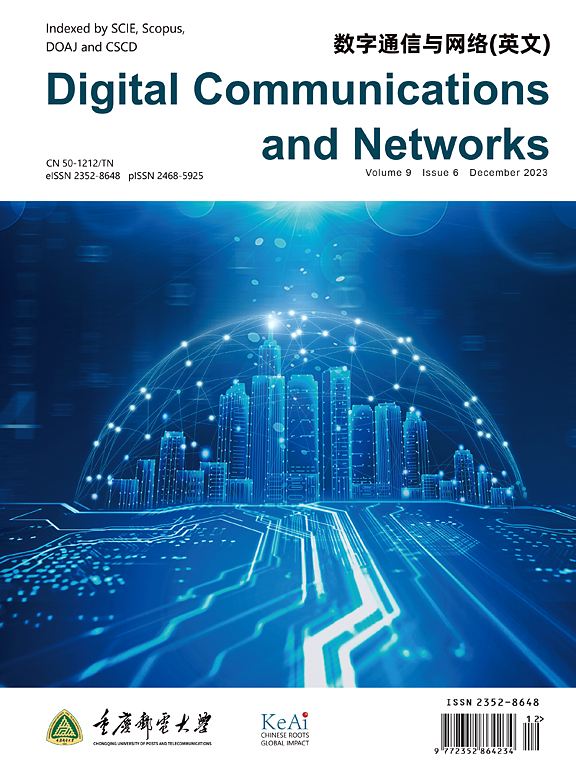实现低成本NOMA的F-RAN的联合用户关联和资源分配
IF 7.5
2区 计算机科学
Q1 TELECOMMUNICATIONS
引用次数: 0
摘要
将非正交多址(NOMA)集成到雾无线接入网(f - ran)中可以有效地提高频谱效率、能源效率、连通性和减少延迟,因此引起了重要的研究关注。然而,支持noma的f - ran的性能改进是以计算开销为代价的,这在其设计和部署中通常被忽略。为了解决这个问题,在本文中,我们提出了一个用于支持noma的f - ran的混合动态下行链路框架。在这个框架中,我们首先开发了一个新的网络效用函数,它考虑了网络吞吐量和计算开销,从而使我们能够全面评估f - ran不同接入方案的性能。在建立网络效用函数的基础上,我们进一步提出了一个受解码顺序、功率分配和服务质量等实际约束的网络效用最大化问题。为了解决这个np困难问题,我们将其分解为两个子问题,即用户设备关联和子信道分配子问题和功率分配子问题。针对这两个子问题,分别设计了三维匹配算法和序列凸规划算法。通过数值结果,我们展示了我们所提出的算法如何通过明智地调整雾接入点的最大发射功率来实现网络吞吐量和计算开销之间的良好平衡。我们还表明,与基于oma的F-RAN相比,提议的支持noma的F-RAN框架可以将网络效用提高89%。本文章由计算机程序翻译,如有差异,请以英文原文为准。
Joint user association and resource allocation for cost-efficient NOMA-enabled F-RANs
Integrating Non-Orthogonal Multiple Access (NOMA) into Fog Radio Access Networks (F-RANs) has shown to be effective in boosting the spectral efficiency, energy efficiency, connectivity, and reducing the latency, thus attracting significant research attention. However, the performance improvement of the NOMA-enabled F-RANs is at the cost of computational overheads, which are commonly neglected in their design and deployment. To address this issue, in this paper, we propose a hybrid dynamic downlink framework for NOMA-enabled F-RANs. In this framework, we first develop a novel network utility function, which takes both the network throughput and computational overheads into consideration, thus enabling us to comprehensively evaluate the performance of different access schemes for F-RANs. Based on the developed network utility function, we further formulate a network utility maximization problem, subject to practical constraints on the decoding order, power allocation, and quality-of-service. To solve this NP-hard problem, we decompose it into two subproblems, namely, a user equipment association and subchannel assignment subproblem and a power allocation subproblem. Three-dimensional matching and sequential convex programming-based algorithms are designed to solve these two subproblems, respectively. Through numerical results, we show how our proposed algorithms can achieve a good balance between the network throughput and computational overheads by judiciously adjusting the maximum transmit power of fog access points. We also show that the proposed NOMA-enabled F-RAN framework can increase, by up to 89%, the network utility, compared to OMA-based F-RANs.
求助全文
通过发布文献求助,成功后即可免费获取论文全文。
去求助
来源期刊

Digital Communications and Networks
Computer Science-Hardware and Architecture
CiteScore
12.80
自引率
5.10%
发文量
915
审稿时长
30 weeks
期刊介绍:
Digital Communications and Networks is a prestigious journal that emphasizes on communication systems and networks. We publish only top-notch original articles and authoritative reviews, which undergo rigorous peer-review. We are proud to announce that all our articles are fully Open Access and can be accessed on ScienceDirect. Our journal is recognized and indexed by eminent databases such as the Science Citation Index Expanded (SCIE) and Scopus.
In addition to regular articles, we may also consider exceptional conference papers that have been significantly expanded. Furthermore, we periodically release special issues that focus on specific aspects of the field.
In conclusion, Digital Communications and Networks is a leading journal that guarantees exceptional quality and accessibility for researchers and scholars in the field of communication systems and networks.
 求助内容:
求助内容: 应助结果提醒方式:
应助结果提醒方式:


